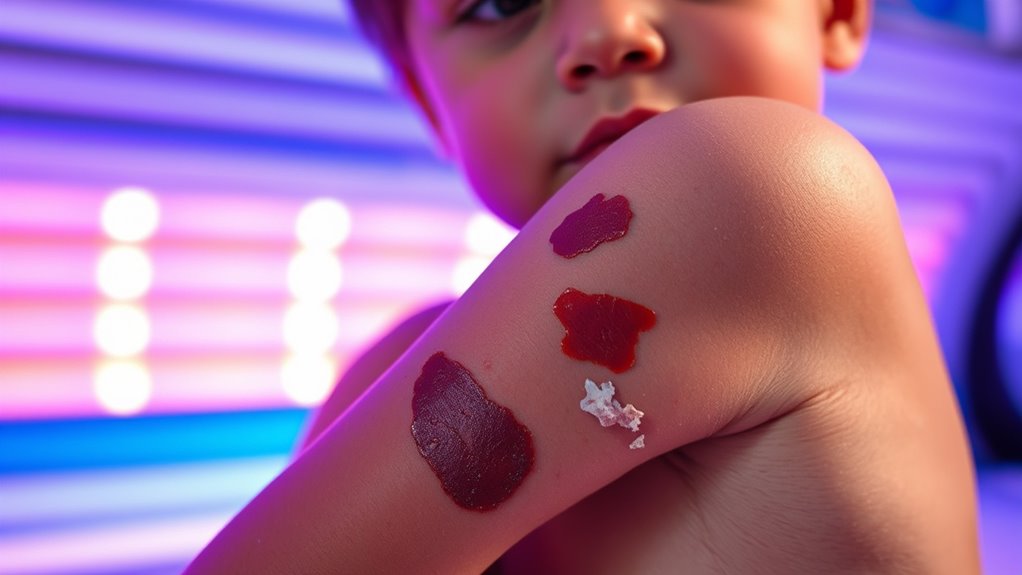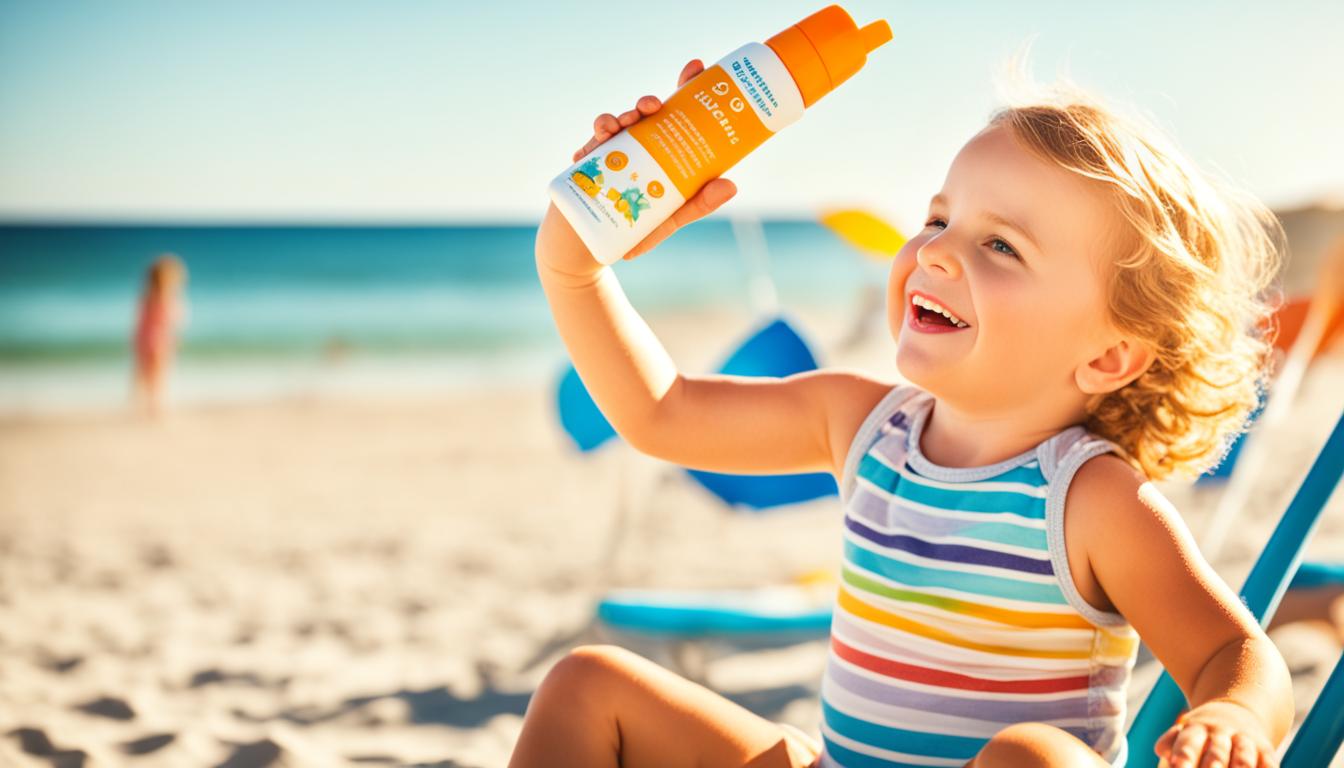Children should avoid tanning beds because the UV radiation they emit considerably raises your risk of skin cancer, including melanoma, later in life. Young skin is especially vulnerable to damage, which accelerates aging and causes long-term health problems. Many misconceptions make tanning beds seem safe, but they produce stronger rays than natural sunlight, increasing harm. Protect yourself now—continue exploring to understand how these risks can impact your future health.
Key Takeaways
- Tanning beds emit high levels of UVA radiation, which significantly increases the risk of skin cancer, especially in young, developing skin.
- Early exposure to UV radiation from tanning beds can cause permanent skin damage, premature aging, and DNA mutations linked to cancer.
- Using tanning beds before age 20 raises melanoma risk by nearly 50%, with risks escalating further for children and adolescents.
- Tanning beds also pose serious eye health risks, including cataracts and vision loss, due to intense UV exposure.
- Many countries restrict or ban minors from using tanning beds to protect children from preventable skin and eye health issues.
The Hidden Dangers of Indoor Tanning for Young Skin

Indoor tanning may seem like a quick way to achieve a sun-kissed glow, but it hides serious dangers for young skin. Every time you use a tanning bed, you’re exposing yourself to UV radiation that increases your risk of skin cancer, including melanoma, squamous cell carcinoma, and basal cell carcinoma. Starting before age 20 raises your melanoma risk by nearly half. Tanning also speeds up skin aging, causing wrinkles, age spots, and leathery texture. It can weaken your immune system, making you more vulnerable to infections. Each session causes DNA mutations, adding up over time and escalating the odds of cancer. The FDA even warns against indoor tanning, emphasizing its carcinogenic dangers. Protect your skin now—tanning isn’t worth risking your health later. Using vetted skincare products designed for delicate skin can help maintain your skin’s health and resilience. Regular exposure to UV radiation from tanning beds not only damages your skin but also increases the likelihood of developing symptoms of skin cancer later in life. Additionally, UV radiation accelerates skin aging, leading to premature wrinkles and age spots. The DNA damage caused by UV exposure accumulates over years and significantly raises your risk of various skin cancers. Proper skin protection measures can further reduce your risk and promote healthier skin.
Early Exposure: A Risk That Lasts a Lifetime

Starting to use tanning beds at a young age can have lasting health consequences. Early exposure increases your risk of developing skin cancer, including melanoma, basal cell carcinoma, and squamous cell carcinoma. If you start tanning before age 35, your chances of melanoma jump by about 75%. Young people are especially vulnerable because their skin is more sensitive to UV radiation. The more you use tanning beds, the higher your lifetime cancer risk becomes. UV exposure also accelerates skin aging, causing wrinkles, age spots, and loss of elasticity. Repeated tanning damages collagen and elastin, making your skin look older faster. Additionally, a significant health concern is the increased likelihood of developing skin malignancies later in life, emphasizing the importance of protecting your skin early on. AI research on safety vulnerabilities highlights the importance of protecting ourselves from harmful exposures like UV radiation, which can have lifelong effects. Regular use of protective measures, such as sunscreen and skin checks, can help mitigate some of these risks. Protecting your skin early on is crucial, as the effects of indoor tanning can last a lifetime, increasing health risks long into the future. Lesser-known spots provide tranquility and privacy, offering a safe alternative for outdoor activities without the risks associated with indoor tanning. Recognizing the long-term health risks associated with tanning beds underscores the need for early preventative measures.
Misconceptions and Lack of Awareness About Tanning Risks

Many people believe that tanning beds are a safe alternative to natural sunlight, but this is a dangerous misconception. Tanning beds mainly emit UVA rays, which penetrate deeply and cause DNA damage, increasing skin cancer risks more than UVB rays. They often emit up to 15 times more UVA than midday sun, and a single session can considerably raise your chance of deadly skin cancer. Despite claims otherwise, no tanning bed is truly safe, and using them before age 20 increases melanoma risk by nearly 50%. Many think a base tan protects against sunburn, but it doesn’t. Each session causes cumulative damage, and lotions sold at salons don’t prevent UV harm. Understanding UV radiation types helps in recognizing the dangers of tanning beds, which predominantly emit UVA rays known for deep skin penetration. Misunderstanding these facts leads to dangerous behaviors and long-term health consequences.
The Impact of Tanning Bed Use on Eye and Skin Health

Exposure to tanning beds can substantially harm your eye and skin health because they emit UV radiation levels that are up to 100 times stronger than natural sunlight. This intense UV exposure damages your eyes’ surface and internal structures, increasing the risk of cataracts, macular degeneration, dry eye, and sunburn of the eye. Cellular DNA damage caused by UV rays may lead to permanent vision loss or blindness. Additionally, repeated UV exposure accelerates aging and damages lens proteins, causing cataracts to form earlier, even in young people. Skin around your eyes is also vulnerable, raising your chances of developing melanoma. Wearing protective eyewear helps, but it doesn’t fully prevent damage. The risks are serious, and avoiding tanning beds is the best way to protect your eye and skin health. Incorporating protective crochet styles for locs can serve as a form of creative, non-invasive protection for hair and scalp. Moreover, understanding the dangers of UV radiation can motivate individuals to take proactive measures in safeguarding their health, especially considering how headphone compatibility ensures safe use with various devices. Recognizing the importance of UV protection strategies can further enhance efforts to minimize exposure and associated risks. Being aware of AI-driven health insights can help individuals make informed decisions about sun safety and health.
Protecting Children: What Parents and Society Need to Know

Children’s skin and eyes are especially vulnerable to the harmful effects of tanning beds, making it essential for parents and society to understand the risks involved. Using tanning beds before age 18 increases melanoma risk by 85%, and raises the chances of squamous cell carcinoma by 58% and basal cell carcinoma by 24%. Some teens develop skin cancer early due to tanning bed exposure, with long-term effects appearing years later. Many countries ban minors from using tanning beds or enforce strict age restrictions, but enforcement can be challenging. Parents should talk openly with their children about these dangers, model sun-safe behaviors, and promote healthy alternatives. Community efforts, education, and healthcare provider guidance are crucial to reduce tanning bed use and protect children’s health.
Frequently Asked Questions
Are There Safe Alternatives to Achieve a Tanned Appearance for Children?
You can achieve a tanned look safely using sunless options like self-tanning lotions, sprays, or bronzers. These products stain your skin without any UV exposure, reducing risks like skin cancer or premature aging. Just remember to choose products suited for sensitive skin, apply evenly, and always use sunscreen afterward. Educate yourself on their limitations and reapply as needed to maintain a natural, healthy glow without damaging your skin.
How Does Indoor Tanning Affect Long-Term Skin Aging in Youth?
Indoor tanning is like setting a timer for premature aging. When you expose your youthfully developing skin to UVA and UVB rays, you damage elastin, making your skin less elastic and more wrinkled over time. This damage can last for years, speeding up aging signs like wrinkles and sagging. Plus, UV exposure during youth increases your risk for skin cancer later, so avoiding tanning beds helps protect your skin’s future health.
Can Tanning Beds Cause Immediate Health Issues Besides Skin Cancer?
You might think tanning beds only cause long-term risks like skin cancer, but they can also lead to immediate health issues. When you use a tanning bed, you risk eye injuries like photokeratitis, which causes pain and sensitivity. You can also get skin burns similar to sunburns, experience allergic reactions, or feel dizzy and disoriented from heat or UV exposure. These immediate effects highlight why tanning beds are dangerous right away.
What Regulations Exist to Prevent Children From Using Tanning Beds?
Your concern about regulations to prevent children from using tanning beds is vital. Some states have strict laws, like complete bans for minors under 18, while others require parental consent or impose age restrictions, but loopholes remain. These regulations aim to protect kids from serious health risks. However, inconsistent laws make enforcement challenging. Enforcing stronger, uniform rules is essential to truly safeguard children from the dangers of indoor tanning.
How Can Schools Effectively Promote Sun Safety Among Students?
You can promote sun safety among students by implementing structured lessons that teach UV risks and protective behaviors, using interactive activities like sunscreen demonstrations. Enforce policies requiring hats and sunscreen during outdoor time, create shaded areas, and schedule outdoor activities outside peak UV hours. Encourage peer-led initiatives, involve parents, and reward consistent sun-safe habits to foster a culture of awareness and protection, reducing students’ risk of skin damage.
Conclusion
You should definitely think twice before letting your kids use tanning beds. Studies show that teens who tan indoors are 74% more likely to develop melanoma later in life. By understanding these risks, you can make smarter choices to protect their health. Keep in mind, early exposure to UV rays can cause lifelong damage. So, instead of risking their future, encourage healthier, safer ways for your children to enjoy the sun.









